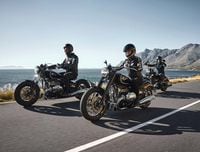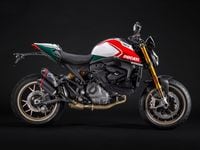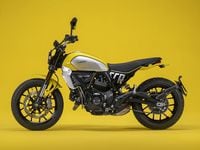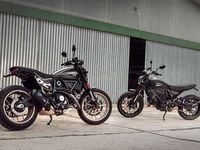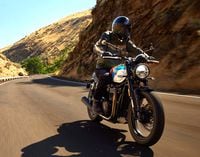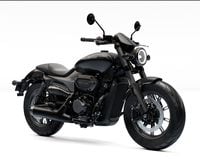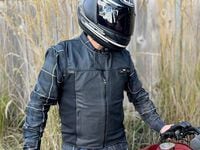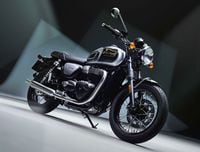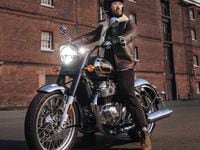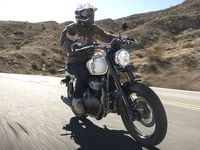It's not like we didn't see this bike coming, but we have to wonder if Victory Motorcycles' hype machine is ready to blow a gasket already. After years of surreptitious announcements, preliminary sketches, sneak previews and soft launches, the New American Motorcycle Company has finally let us lay hands (and butts) on its newest "way out" design, the Vision touring motorcycle. And it's like nothing we've ridden in a very long time.
As the first new American luxury touring bike to hit the market in 30 years, the Vision more than strikes a pretty pose-its slippery curves and languid flow put Sports Illustrated swimsuit babes to shame. At the soft launch last December, the Minnesota-based company described the Vision as "the most progressive American luxury touring bikes ever built." Strong words, but even at first glance you could see where they were coming from: Dramatic styling like this is bound to get a strong reaction from both sides of the aisle. It's certainly no Electra Glide-which is, not coincidentally, one of the bike's primary competitors.
The Long Road
A culmination of six years of R&D; and a huge stylistic and technological leap, the Vision project is unlike some past efforts, which chose to ladle new parts onto an existing chassis (read: Jackpot). The Vision is pretty much all-new, with a mere sprinkling of parts shared with other Victorys in the catalog. The design staff, headed up by former BMW design whiz kid Greg Brew, seemed to sense that draping a slinky new hunk of bodywork atop one of its last-generation engines would be like slipping lingerie onto Dr. Ruth and hitting the runway.
That's probably why Victory spent $5 million developing a suitable core for the Vision-the 106/6 Freedom V-twin engine. With a 106-cubic-inch (1,731cc) displacement, the newest Freedom mill is said to pump out 92 horsepower and 109 ft-lbs. of peak torque, but central to the design theme is the engine's visual element. Sculpted bodywork along the forward cylinder echoes lead designer Michael Song's distinctively scalloped fuel tank and, when viewed straight on, cozily frames that 50-degree V-twin much like, to use Victory's catchphrase, "a jewel in the setting." A similar treatment is repeated out back, with the twin exhaust pipes nestled into scooped slots under the locking hard-shell saddlebags (one on each side). In the bike's face (and it has a wide one) you can detect bits of BMW R 1200 RT (with shades of the newer GT thrown in for good measure), but the wild, shapely Jetsonian curves of the huge taillight area are like nothing else on the road.
Though undeniably modern, the Vision's long, low lines continue the design language begun with the Vegas. The only obvious betrayals of the bike's cruiser- based platform are a conventional, Kingpin-esque 43mm telescopic fork (though the Vision's isn't inverted) and the ubiquitous carbon-fiber reinforced belt drive that appears on all Victory models. Like its perceived competition, the Vision wraps its skeleton in acres of flowing plastic, choosing to highlight only the Freedom V-twin power plant as, ahem, the "jewel in the setting."
Um, Closer...
Beyond that, Victory says the design of the bike was driven by the Voice of the Customer. The firm's research says that the Customer is overwhelmingly male, married, rides mostly with his significant other and has a good amount of riding experience. And most importantly, He's most interested in just two things-style and comfort.
Clearly, the style part of the equation is handled on the Vision, while the emphasis on relaxed ergos is evident upon closer inspection of the finished design. Things like the extraordinarily long floorboards and the lowest seat height in class, 4 inches of extra padding on the saddle and adjustable foot controls serve to distinguish this bike from its competition.
The Vision is actually two motorcycles based on the same platform. The full-boat version is called the Vision Tour, and its distinguishing feature is the generously sized top case that is missing from its very close relative, the Vision Street. The Tour version's 29.2 gallons of storage doubles that of the Street's.
The Street model is geared toward the occasional, solo weekend rider more interested in short hops, while the Tour owner is perceived to be a more hard-core, long-distance rider. Beneath the 21st-century PC/PBT composite exterior of both lies some fairly conventional geometry, such as a 29-degree rake, 5.4-inch trail and 65.7-inch wheelbase that's right in line with the Honda Gold Wing's 29.1-degree rake and 66.5-inch wheelbase. There's more news under the hood, though. In addition to the bigger 1,731cc V-twin engine, the six-speed transmission's been redesigned for a lower-ratio first gear and slightly higher sixth gear. In truth, the power train is more a major upgrade to the last-generation base 100/6 (which also gets its own upgrades for 2008) rather than a complete ground-up design.
The split fuel tank perched on the front of the cast-aluminum frame (to keep weight down) is the other indication you're not in Kansas-or Milwaukee, for that matter-anymore, but most other components and systems on the bike are freshly minted, too. The innovative, elongated one-piece airbox that's married to the frame enhances forward intake for more power, and the new closed-loop fuel-injection system is stuffed with new throttle bodies, injectors and oxygen sensors engineered to run cleaner, more efficiently and to pump up the power. Additional components like new camshafts, primary drive with a retuned torque compensator and a split gear on the clutch help damp what engineering geeks call noise, vibration and harshness.
Show Me The Money
All the hype, propaganda and PowerPoint presentations vanished when we stepped up to the sculpted saddle. Across 500 miles of Minnesota, Wisconsin and Iowa farmland on the Vision Street and another 100 or so on the Tour model, we flogged the bikes. Along Highway 35 in Minnesota, alternatively known as the Great River Road, we rode down into the area that has the best twisties in this part of the world-Bluff Country.
Along the way, the Vision delivered. Psychologically, visually and literally, the heart of the bike is that 1,731cc, air-and water-cooled V-twin, exposed for all to see. Despite weighing in at a cool 804 pounds (Harley's Ultra Classic Electra Glide comes in at 808 pounds), the Vision Street's low center of gravity and 26.5-inch seat height means more maneuverability than you'd expect, especially for those with shorter inseams who like to know the terra is a little firma beneath their feet. The seat also has a narrow taper to the front rider section, which likewise allows a direct stab to the asphalt. Because of this, you sit in the Vision rather than on top of it, with the rubber-mounted pullback bar comfortably in reach.
Thumb the starter on the Street and the fuel-injected, 92-hp mill catches easily (though I got strangling sounds on my Tour test unit), warms up calves quickly and thumps out a not-quite guttural tune. With 90 percent of its 109 ft-lbs. of torque coming at a subterranean 2,000 rpm, the Vision Street pulls readily and persuasively off the light.
Twist the throttle and you'll get hearty acceleration in any gear, but it's not of the ears-pinned-back variety-the Vision's laid-back vibe is better suited for easy cruising than a street race. For a relatively free-revving engine, it gives a surprising amount of low and midrange grunt-not quite as much as the slow-revving, heavy-flywheel big twins, but it's right up there. The progressive throttle linkage (and a heavy pull) makes the bike feel soft just off idle, but there is a surprisingly satisfying intake honk to savor.
The roomy integrated floorboards are spacious, and long-legged types should have no problems stretching out on a long haul. Our 5-foot 7-inch frames had no complaints over the course of 200 miles. The 'boards are also hinged and offer substantial ground clearance.
We were also impressed by the laterally adjustable gear-shift lever, as it was a stretch to the shifter for our smallish 30-inch inseams. For some reason, we also couldn't help but think there was a heel lever missing-this bike seems to cry for a heel-toe shifter. In Victory's defense, this would essentially lock your foot into a single position, thus wasting all that floorboard space.
On our longest day (350 miles), the amply padded seating served up a comfortable cockpit all day, with little saddle soreness afterward (though the rear of the seat pan does come up rather steeply). At high speeds, the Vision's 65.7-inch wheelbase delivered good stability even with all that bodywork-and we were subjected to some fierce crosswinds (on the Tour version, the gusts proved rather unsettling). The Tour's topbox does give you more storage-enough to lock up two full-face helmets-but we didn't prefer that bike's handling characteristics and rear weight bias. We also noticed some whine in the upper gears of both bikes, i.e., third and fourth, which was only noticeable because fifth and sixth were glass-smooth.
If you imagined the Vision delivering the long-range comfort of a Gold Wing with the presence of a big V-twin, you'd be close-the bike manages to split the difference between the Harley's more textured ride and the Gold Wing's eerie smoothness. When it comes time to stop the party, the Vision's new linked-brake system works well on the Street version, and it makes sense to use both brakes when stopping an 800-pound motorcycle anyway (especially when the front one's a little soft). Here, the front lever activates only the front calipers, but the rear pedal activates the rear caliper as well as the front calipers, depending on the force used. The medium-to-heavy lever effort is on par with other Victorys', and it's position adjustable. As you'd expect on a touring bike, the rear suspension is also adjustable. The mono air shock (with a coil spring inside) is modulated with inflation: for a stiffer ride, you can pump compressed air into the system via an accessible valve on the side of the bike. It's a simple adjustment, provided you can find a gas station with an air hose (and adapter) or carry your own.
What was especially unique, though, was the bikes' tip-over feature. It's essentially comprised of a pair of strategically positioned metal rockers located near the floorboards (with another pair in the rear) that really work to keep the bike from completely rolling onto its side if dropped. We witnessed a hapless rider lose purchase while walking a bike around, and as advertised, the bike listed over just a few inches until it met pavement and stopped.
We also approved of the adjustable windshield (with optional electronic control) because it allowed us to modulate ventilation and turbulence levels easily. With wicked heat chasing us on the plains, the shorter, blade-style shield of our Street model proved more to our liking-the Tour's taller unit blocked any breezes from reaching our torso.
Folding Lexan winglets under the very wide, fixed mirror assemblies also tweak the turbulence, but if all that wind noise is just too much, options like XM satellite radio, iPod or CD connectivity can tailor the sound to your liking. As for those electronics, we were quite satisfied with the user-friendly Garmin GPS on our Street test unit and the intuitive interface for all of the features. Controls were comfortably positioned and easily accessed on the dash and nicely positioned handlebar, and the speakers pumped our iPod's music through with authority (though at high speeds some of the bass was lost).
Love It Or Hate It
No matter how you slice it, the Vision's 21st-century personality and features are impressive; we're glad the company went for the gusto and opted for a radical design. The bold presentation brings to mind Honda's Rune-in the sense that it's one of the most forward-looking designs to enter mass production. The Vision has a well-thought-out feature set and attractive lines; the rear of the Street version especially has a muscular feel to it, and for my money, it's the winner in the styling sweepstakes.These eye-catching motorcycles should make for able contenders in the luxo touring wars, regardless of any hype.
Vision Tech
Talking Shop With The DesignersThe Vision is the result of years of concept designs and refinements. Designer Michael Song explains how it all got started.
Motorcycle Cruiser: Is it safe to assume that the Visteon concept bike was the catalyst for the Vision?
MS: I wouldn't say the Visteon was the catalyst but rather a reference point. A reference to how accepting touring riders were at the 2001 Sturgis intro and how much further we had to pushin our design.
MC: Which came first-the Visteon or Victory's desire to get into the touring market?
MS: Our desire to get in to the luxury touring market was there from the start. We weren't ready at the time, but the Visteon concept was a good opportunity to test the market and creatively have some fun.
MC: Presumably, the higher-ups gave you input into the functionality they wanted. Did you come up with the long and flowing design based on that?
MS: When the type of bike or segment is determined, we have a pretty clear idea what that rider is looking for. We go through lots of research before functional features are finalized. As concepts are developed, they have to embody the attributes of the New American Motorcycle brand. Long, low and flowing lines are one of the characteristics of our design, which originated from Vegas.
Designing a bike with so many angles and curves can be a manufacturing nightmare. Greg Brew, the chief industrial designer at Polaris and a former designer at BMW motorcycles, acknowledges the Vision offered an especially unique set of challenges:
Traditionally, motorcycle bodies are made with either steel or ABS (acrylonitrile butadiene styrene). Steel was quickly ruled out as too heavy a material for the Vision, while ABS, says Brew, is too labor-intensive and the desired gap tolerances would be difficult to achieve.
"We knew we needed a material that would provide more of an automotive-type finish while strictly limiting gaps. We also needed the body to be as light, yet as durable, as possible."
The solution was found with one of Victory's plastic suppliers. The 26 painted body panels used on the Vision would instead be injected molded with PC/PBT composite (a blend of polycarbonate and polybutylene terephthalate), a material more commonly used for automobile bumpers, trim and side moldings.
Jason Hoeve, program leader for the Vision, explains that while PC/PBT is more expensive per pound than ABS, there's a savings in the long run. That's because an adhesion promoter needs to be applied as a primer when painting ABS, which adds a step to the process. Primer isn't required for PC/PBT, so "the finished parts cost less because you don't have the extra process," according to Hoeve.
Meanwhile, Brew is happy with the gap tolerances being achieved with PC/PBT thanks to its low thermal-expansion rate (other plastics expand and contract more, thus requiring bigger gaps between mated parts).
What's In The Package?
The Vision comes in several trim options and special packages, which add style, comfort or performance enhancements to the base model.
Victory Vision Street$18,999 The base model includes a halogen headlight, cast wheels, cruise control and a manually adjustable shield.
Vision Street Premium$24,999
Same basic features as the standard Street, but adds lit Victory logo badges on the tank, an HID headlight, an electrically adjustable shield, heated handgrips and a premium chrome package
Victory Vision Tour$19,999
The base Tour model includes the same features as the Street model, but with the lockable topbox.
Vision Tour Comfort $24,999
This package adds the electrically adjustable shield, electrically heated grips and heated seat to the base model
Vision Tour Premium$21,999
HID headlight, lit badges, premium audio and premium chrome package
Victory also says more than 60 accessories will be available, designed especially for and in conjunction with this model.
Among these will be:
XM Radio
CB radio
10-disc CD player
Vision GPS from Garmin
Heated handgrips
Heated seats
Electric windshield kit
Chrome bodywork (access panel,engine trim, passenger floorboards, etc.)
Different height windshields-
tall, low and Blade (lowest)
Passenger backrest
Footrest risers
Rear trunk (to add to Street model)
Performance exhaust (two levels, following same lines as stock exhaust)Exhaust tips
Tourer Or Cruiser?
Is The Vision A Touring Cruiser Or Simply A Tourer?Victory positions the bike as a competitor to Harley's Ultra Classic Electra Glide, BMW's K 1200 LT and Honda's Gold Wing in the "luxury touring segment." Those are arguably three very different answers to the touring question, but in ways similarly focused. It's in the differences that Victory saw its opening.
The company determined the touring market was sliced up into distinct groups-none of which overlapped. The import brands-Honda and BMW-stress modern styling and a more ready, upright-riding position, while the American brand-Harley-goes for more relaxed ergos and emphasizes heritage in the styling. The open niche was a bike with American heritage yet featuring uniquely modern styling and a relaxed riding position-the Vision.
After that, marketing wonks stress, they extensively "benchmarked the competition." "We've studied the Gold Wing, the BMW K 1200 LT, the Ultra Glide. And we think we have something totally different," says Gary Gray, product manager, Victory Motorcycles.
Judging by the numbers, they do. The Gold Wing base model retails for $19,599, and packs on 1,832cc of displacement, a five-speed tranny (plus reverse) and a 6-gallon fuel tank. BMW's K 1200 LT starts at $21,770, displaces 1,172cc and also has five gears (and reverse) and a 6.2-gallon fuel capacity. And the base-model Electra Glide Classic is priced at $18,095-though the more comparable Ultra model (with the topbox) starts at $20,195. It features a 1,584cc engine, a 5-gallon fuel capacity and six gears. Seat heights for all three average around 30 inches.










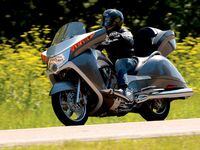
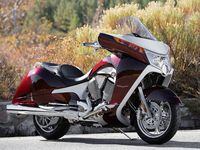
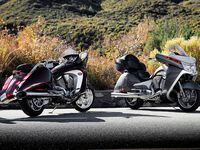

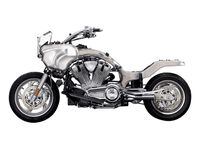
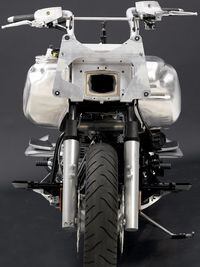
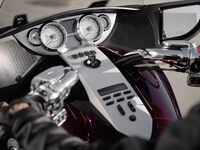

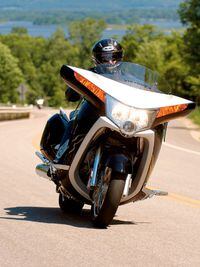
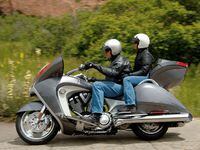
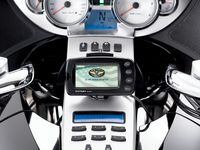
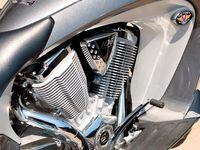
/cloudfront-us-east-1.images.arcpublishing.com/octane/H6Z2IC7WYRBXZNQS4MI3SZ5KPQ.jpg)
/cloudfront-us-east-1.images.arcpublishing.com/octane/IWO5T5PBT5E4HFQ5GK47H5YXR4.jpg)
/cloudfront-us-east-1.images.arcpublishing.com/octane/OQVCJOABCFC5NBEF2KIGRCV3XA.jpg)
/cloudfront-us-east-1.images.arcpublishing.com/octane/F3O2DGLA4ZBDJGNVV6T2IUTWK4.jpg)
/cloudfront-us-east-1.images.arcpublishing.com/octane/ZXYQE3MHLFDSPKNGWL7ER5WJ4U.jpg)
/cloudfront-us-east-1.images.arcpublishing.com/octane/RDF24VM7WVCOBPIR3V3R4KS63U.jpg)
/cloudfront-us-east-1.images.arcpublishing.com/octane/W7RSIBFISNHJLIJESSWTEBTZRQ.jpg)
/cloudfront-us-east-1.images.arcpublishing.com/octane/AERA26ENRNBW3K324YWCPEXYKM.jpg)
/cloudfront-us-east-1.images.arcpublishing.com/octane/YWX3YX7QBBHFXFDMEEEKRG4XJE.jpg)
/cloudfront-us-east-1.images.arcpublishing.com/octane/I7OKI53SZNDOBD2QPXV5VW4AR4.jpg)
/cloudfront-us-east-1.images.arcpublishing.com/octane/IH52EK3ZYZEDRD3HI3QAYOQOQY.jpg)
/cloudfront-us-east-1.images.arcpublishing.com/octane/K2FSAN7OWNAXRJBY32DMVINA44.jpg)
/cloudfront-us-east-1.images.arcpublishing.com/octane/G4XK7JL24FCUTKLZWUFVXOSOGE.jpg)
/cloudfront-us-east-1.images.arcpublishing.com/octane/JJNXVAC27ZCDDCMTHTQZTHO55Y.jpg)
